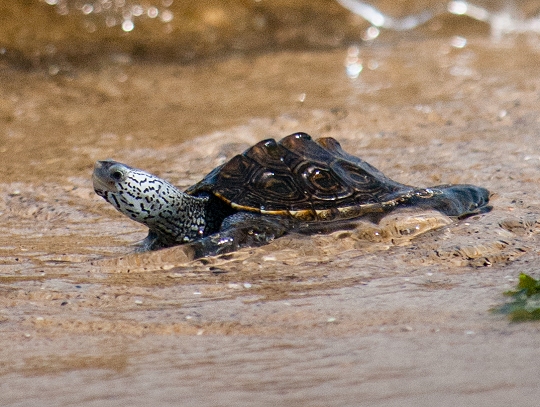 A juvenile diamondback terrapin (Malaclemys terrapin) is released by staffers from the Chesapeake Bay Program offices in Annapolis, Md., on July 17, 2010. (Photo by Alicia Pimental/Chesapeake Bay Program, CC BY-NC 2.0 license via Flickr)
A juvenile diamondback terrapin (Malaclemys terrapin) is released by staffers from the Chesapeake Bay Program offices in Annapolis, Md., on July 17, 2010. (Photo by Alicia Pimental/Chesapeake Bay Program, CC BY-NC 2.0 license via Flickr)Some days, you hit it right. I offer into evidence Tuesday, June 7, 2016. Towing a fine-mesh net for plankton in a Virginia inlet, our apparatus was fairly clogged with red-fringed clam worms, bottom dwellers summoned by the new moon from their homes in the dark sediments to wriggle and mate, then gloriously die at the sun-spangled surface.
On the backside of a nearby beach, we seined up silverside minnows full of eggs and sperm, ensuring the continuation of a species that, along with menhaden and bay anchovies, form the forage base for striped bass and other predator fish.
Mixed in with the minnows were more wrigglers: little eels spawned last fall in the cold black depths of the faraway Sargasso Sea, delivered here by ocean currents, destined to populate rivers and streams throughout the Chesapeake and East Coast. Years from now—cued by what, science really doesn't know—they will somehow navigate back to the Sargasso deeps, expiring there in a burst of reproduction with eels from across North America.
From a clump of marsh burst a big female diamondback terrapin, headed landward to excavate a nest and deposit her clutch of soft, leathery pinkish-beige eggs. By the distinctive terrapin tracks scrawled all along the sandy shore, she was not alone this hot June morning.
Gliding into the warm shallows came a female horseshoe crab. Soon, a male would emerge and attach with special clasper claws to the rear of her shell. She'd drag him to the high tide line to fertilize the eggs she'd inject into the beach edge. At peak spawning on the full and new moons in May and June, a mammoth outpouring of horseshoe eggs provides fuel for migrating shorebirds from as far off as Argentina and Brazil.
As my college class pulled the seine, I wandered down the marsh edge, spooking a railbird from her nest, exposing 10 mottled eggs. In the next few hundred yards, had I been a fox, I could have gorged my fill on several more just like it.
In a few more days, water temperatures were set to trigger an explosion of sperm and eggs from oysters that lined the coves and marsh banks. As the tide receded, exposed mudflats began to swarm with flights of migrating shorebirds extracting feisty fiddler crabs from their burrows.
All of what I've described above was the barest sample from the merest scrap of the edges of land and water that define and enliven our planet. Chesapeake Bay alone has perhaps 11,000 miles of such land-water merge. Most of the year, in the classroom, I preach the concept of these edges: the most productive ecosystems on Earth, from mangroves and coral reefs to tidal wetlands and seagrass meadows and oyster rocks—all of these nurturing an astounding quantity and variety of bird and fish life. They are also the most seductive ecosystems on Earth, with half of the world's human population living on about 5 percent of the globe, most of that near the natural bounty of the edges.
There is no better place to learn peaceful coexistence between us and the rest of nature. And the concept is fine enough; but it is days like today, out here with life just detonating all around and above and beneath you, that affirms it in a way no PowerPoint or lecture or nature film could ever do.
It's the reason for this class, which takes students in kayaks camping for a month around Delmarva, a peninsula washed by Chesapeake and Delaware bays and the Atlantic, and divided by the Chester, Choptank, Nanticoke and Pocomoke rivers.
A typical reaction from people we meet: "Wish I could have gotten six credits for that when I was in school." Amen.
We see it all, from fresh to salt, from the solitude of quiet creeks and cypress swamps, to the big salty waters in sight of Norfolk and Virginia Beach—the last week capped with a 40-mile paddle from Dorchester County south to Smith and Tangier islands. Always, we're following those edges.
And in recent years, we're looking at the edge through another lens, that of traveling a landscape that will change drastically in the students' lifetimes. One of our maps shows in shades of orange the land we're destined to lose around the region to sea level rise. It's dated 2010 and predicated on a rise of about a meter by 2100—which is already beginning to look conservative.
There will still be edges of land and water, just farther inland. Many islands will depopulate or disappear. Many peninsulas, including the huge Delmarva, will be skinnier. The best we can do is to leave the vital edges room to migrate; stop developing there.
And of course, do all in our power to forestall the worst of climate change. If you need reasons, start with appreciating the amazing fecundity of life where water meets the land.
Tom Horton has written about Chesapeake Bay for more than 40 years, including eight books. He lives in Salisbury, where he is also a professor of environmental studies at Salisbury University.


